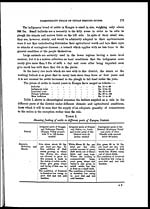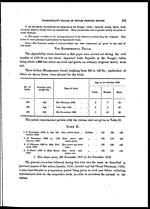Medicine - Veterinary > Veterinary colleges and laboratories > Indian journal of veterinary science and animal husbandry > Volume 1, 1931 > Part III (September 1931) > Some digestibility trials on Indian feeding-stuffs, Part VII. Kangra rice straw
(220) Page 180
Download files
Individual page:
Thumbnail gallery: Grid view | List view

180 THE INDIAN JOURNAL OF VETERINARY SCIENCE AND ANIMAL HUSBANDRY [ I, III
TABLE I—contd.
Showing feeding of cattle in different parts of Kangra District—contd.
|
Irrigated parts of Kangra |
Irrigated parts of Nurpur |
Unirrigated parts of the |
|
|
and Palampur Tehsils, |
and Dehra, i.e., lower |
District (Hamirpur Tehsil |
|
|
Period |
(Kangra Valley proper) |
and hotter parts of the |
and parts of other |
|
with 75 to 100 inches |
District with 50 |
Tehsils) with rainfull |
|
|
rainfall |
inches rainfall |
below 50 inches |
|
|
April, May and |
Wheat and barley Bhusa |
Wheat and barley Bhusa |
Wheat, barley and gram |
|
June. |
about 20 lbs. per head |
about 20 lbs. per head |
Bhusa and dry grass 20 |
|
per day. There is practi- |
per day. There is prac- |
to 24 lbs. per head per |
|
|
cally no green matter to |
tically no green matter |
day. There are com- |
|
|
be fed to the cattle. The |
to be fed to the cattle. |
paratively more grazing |
|
|
plough bullocks during |
The plough bullocks |
lands and meadows and |
|
|
heavy work are given 1 |
during heavy work are |
hence there is more dry |
|
|
to 2 lbs. of concentrates |
given 1 to 2 lbs. of |
grass, etc., in this area |
|
|
per head per day. |
concentrates per head |
than the irrigated parts |
|
|
per day. |
of the District. The |
||
|
plough bullocks during |
|||
|
the heavy work are given |
|||
|
1 to 2 lbs. of concen- |
|||
|
trates per head per day. |
|||
|
July, August and |
20 lbs. of white Bhusa plus |
Green grass 30 to 40 lbs. |
Green grass as grazing |
|
September. |
20 to 30 lbs. of green |
which includes cut grass |
with about 16 lbs. of |
|
grass cut from lands of |
and whatever the cattle |
Bhusa at night. The |
|
|
rice and maize fields. |
can get from grazing |
condition of the cattle |
|
|
The condition of the |
plus a little chari which |
during this period is |
|
|
cattle during this period |
is grown by very few. |
satisfactory and is pro- |
|
|
is satisfactory and is pro- |
The condition of the |
bably at its best. |
|
|
bably at its best. |
cattle during this period |
||
|
is satisfactory and is |
|||
|
probably at its best. |
|||
|
October, Novem- |
Rice straw 20 to 24 lbs. |
Rice straw and maize |
Maize stalks, Mash Bhusa, |
|
ber and Decem- |
per head per day with |
stalks and Mash Bhusa |
Kulth Bura (legumes) |
|
ber. |
some leaves of trees like |
30 to 40 lbs. per head |
dry grass and leaves of |
|
Dhaman, Sirs, kard, |
per day with leaves of |
trees like Dhaman, |
|
|
Khirk and bamboo, etc., |
trees like Dhaman, Sirs, |
Chhal, etc. The condi- |
|
|
according to the quantity |
Khich, Karal, Bhera, |
tion of cattle is satisfac- |
|
|
available plus 1 to 2 lbs. |
bamboo, etc., 1 to 2 lbs. |
tory. |
|
|
per head per day of con- |
per head per day and |
||
|
centrate is given to |
concentrate is given to |
||
|
bullocks during heavy |
bullocks during heavy |
||
|
work. The condition of |
work. The condition of |
||
|
cattle is middling. |
the cattle is middling. |
General Note.—A perusal of the above statement shows :—
1. In Kangra Valley proper with very intensive system of farming and with rice and wheat as
staple crops and with very small grazing area, the fodder supply is not only inadequate but very
defective which is borne out by the fact that a great majority of cattle are fed from October to March
on a ration which is mostly composed of rice straw with a little addition of green matter. This
continued poor and unbalanced ration during the wet and cold months (temperature frequently going
below freezing point) lowers the vitality of the cattle.
2. The supply of fodder in the irrigated lower and hotter parts of the District is a little better
than the Kangra valley proper.
Set display mode to: Large image | Zoom image | Transcription
Images and transcriptions on this page, including medium image downloads, may be used under the Creative Commons Attribution 4.0 International Licence unless otherwise stated. ![]()
| Permanent URL | https://digital.nls.uk/75226454 |
|---|
| Description | Covers articles from 1931. |
|---|




